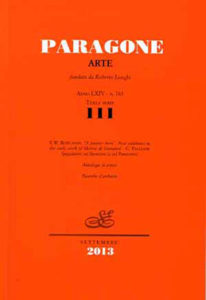Paragone Arte 111

Anno LXIV – Terza serie – Numero 111 (763) Settembre 2013
Eliot W. Rowlands: “A painter born”. New additions to the early work of Matteo di Giovanni
Carlo Falciani: Spigolature sul Bronzino (e sul Pontormo)
ANTOLOGIA DI ARTISTI
I dipinti di Andrea Pozzo per il padre generale Giovanni Paolo Oliva: un felice ritrovamento (Laura Facchin, Andrea Spiriti)
Several drawings and paintings by Baratta, the last gasp of the Genoese baroque (Mary Newcome Schleier)
RICERCHE D’ARCHIVIO
Per lo scultore genovese Domenico Garibaldo (Daniele Sanguineti)
SUMMARY
ELIOT W. ROWLANDS
Quattro pannelli raffiguranti Sant’Agostino, San Gregorio Magno, Santa Margherita e Santa Caterina d’Alessandria vengono qui proposti come opere del pittore senese Matteo di Giovanni. Mostrano, infatti, la persistente influenza delle opere del Vecchietta e del Sassetta, riconosciuti come maestri di Matteo. Per questo motivo e per le stringenti analogie con tre pale giovanili dell’artista — quella già in San Giovanni in Val d’Afra oggi a Sansepolcro, quella di San Pietro a Ovile a Siena e la Madonna col Bambino e quattro santi di Asciano – i pannelli possono essere datati intorno al 1455-1460. Si ipotizza, inoltre, che altri due pannelli recentemente datati allo stesso periodo (il San Nicola di Bari di Altenburg e il San Gerolamo di Esztergom) provengano dallo stesso, non rintracciato, polittico.
CARLO FALCIANI
This article studies stylistic evolution in a group of works by Bronzino and Pontormo, some of them exhibited at the Palazzo Strozzi in Florence in 2010-2011 (Bronzino pittore e poeta alla corte dei Medici). With respect to the catalogue of that exhibition, a different attribution is proposed for the Evangelist roundels in Santa Felicita, and new dating is offered for the Saint Sebastian in the Museo Thyssen, Madrid, the Saint John the Baptist in the Borghese Gallery, Rome, and the Portrait of Bartolomeo Panciatichi in the Uffizi. As regards the relationship between Bronzino and Pontormo, the author once again discusses the attribution of a Virgin and Child formerly given to the latter but now returned to Bronzino. Two further attributions to Pontormo are suggested, for a panel with the story of Marcus Curtius and an unpublished Virgin and Child with Cherubs. A concluding discussion addresses the attribution to Francesco Salviati of the Portrait of a Man in the Getty Museum, Los Angeles, with a proposal for the traditional authorship of Bronzino.
LAURA FACCHIN, ANDREA SPIRITI
Andrea Pozzo’s shipment of two paintings to the Father General of the Jesuit Order Giovanni Paolo Oliva in 1679 provided the immediate introduction for the painter’s move to Rome, and for his key role in the Society’s artistic politics. The two hitherto unidentified works (a Saint Mary Magdalen and Saint John Chrysostom in Dialogue with Saint Basil of Raphanea) have just been rediscovered in the Vatican storerooms, and are presented here with a dual reading: on the one hand, emphasis on their full integration within Pozzo’s oeuvre (with strong echoes of the Milanese tradition), and on the other, consideration of their complex iconography, which to some extent sums up the artist’s own spiritual journey. The author also reconstructs the events that took the works from an original Jesuit context to their current location.
MARY NEWCOME SCHLEIER
In questo contributo si prendono in esame due disegni preparatori di Carlo Alberto Baratta (1754-1815) che permettono di identificare le pale d’altare di Camogli e di Bogliasco, confermando così le notizie offerte dalla biografia dell’artista di Federico Alizeri.
DANIELE SANGUINETI
Among the pupils of Filippo Parodi recorded by the biographer Carlo Giuseppe Ratti, the sculptor Domenico Garibaldo (1687-1756) is the least well-known, given the dearth of documents about him; yet his career, which evolved entirely in Genoa, was, for generational reasons, influenced by both late Baroque culture and the new styles fostered by the Accademia Ligustica (founded in 1751), of which he was a member. The discovery of a notarial contract of 1721 relating to two sculptures destined for the parish church of the Assunta in Sestri Ponente, just west of Genoa, now provides an important point of reference for the reconstruction of the artist’s oeuvre, while a study of the works — a Saint Dominic and a Saint Rose of Lima — offers useful information for his training after Parodi’s death in 1702.
